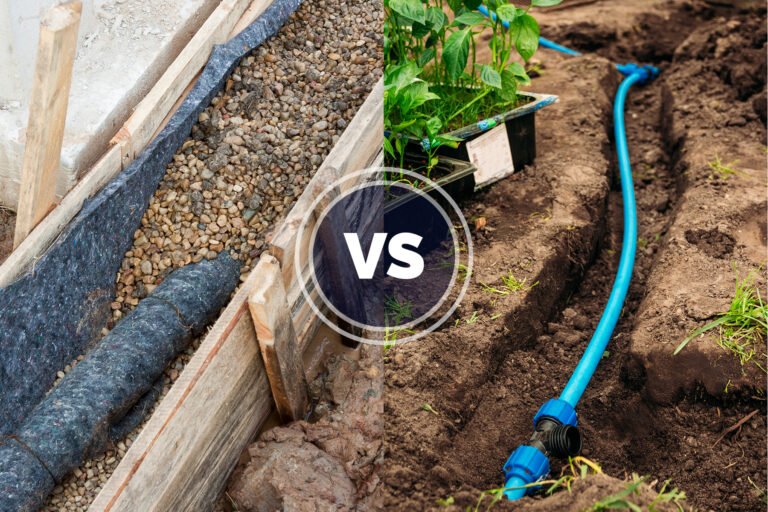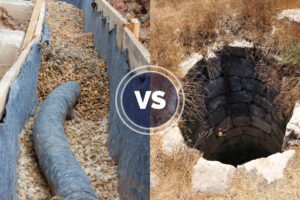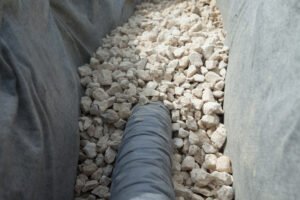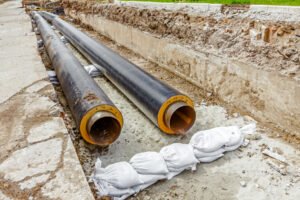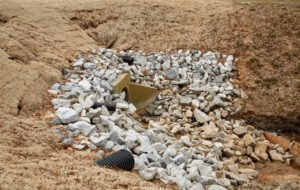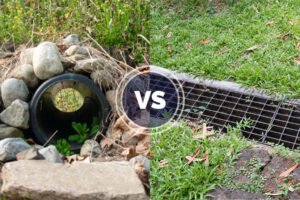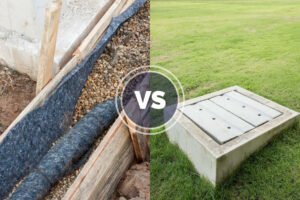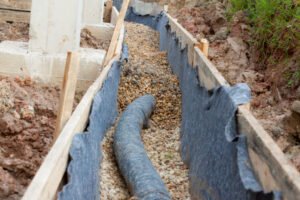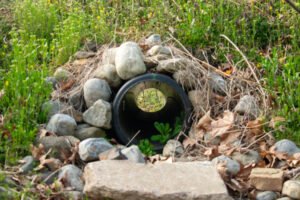Surface water drainage is undoubtedly a bigger problem than it seems. It looks and smells awful and might damage your basement and foundation with continuous water percolation. Plus, the excess water might backflow to the house and wreck your yard.
Surface drainage systems like french and curtain drains are a boon in such cases. But they must suit the terrain, soil, and rainfall in your area. You can choose a french drain or curtain train based on your yard design, and we will help you with the selection!
We differentiated the various uses, mounting styles, and depths of curtain and french drains, along with some comparison points and FAQs for better understanding. So, let’s start analyzing!
What Is a French Drain?
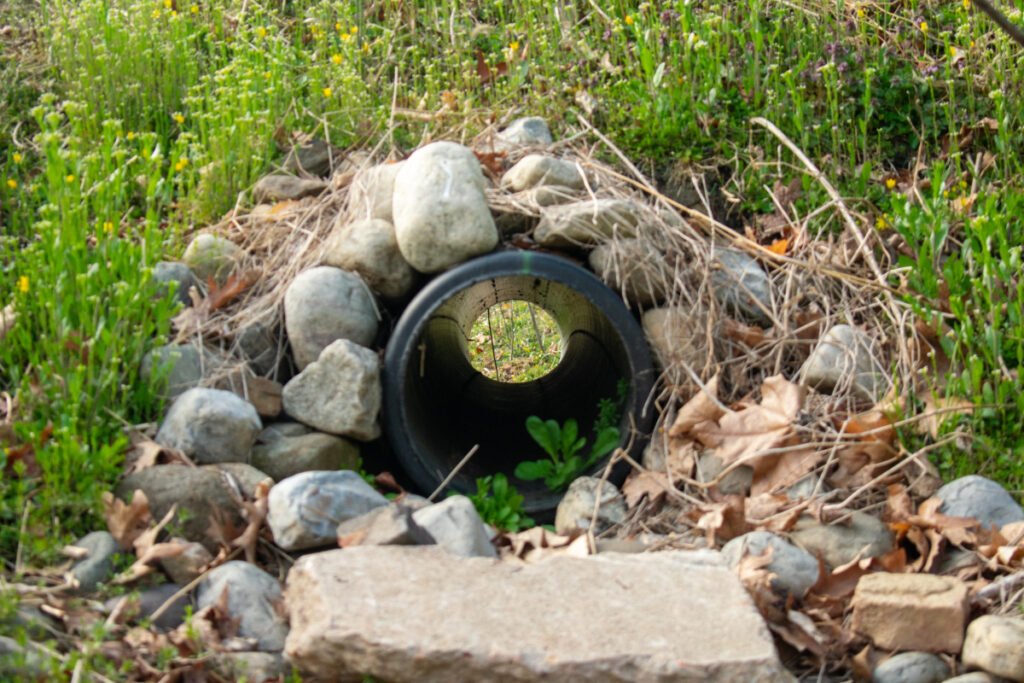
What Is It: A french drain is a foundation drainage system with gravel, soil, and a perforated pipe that directs the water flow to low-lying areas using gravity.
How Does It Work: A french drain collects all the surface water in a rock trench, filters the soil and sediment, and moves it to low-lying areas using a french drain pipe. It may have additional bunds or crawl space to trap soil and prevent clogging and erosion.
A french drain deals with groundwater percolation, flooding, and damage, unlike a curtain drain that absorbs surface water. It is deeper and wider than a curtain drain, has a better water-holding capacity, and towers the hydrostatic pressure from sub-surface elements.
Moreover, french drains are like footing drains and hide well under lawns and driveways. They have a ditch, a weeping tile, and a larger drainage pipe that makes them capable of handling heavy rain and pressure.
However, a french drain installation is tedious and needs professional help. And, it might even clog or retain standing water with faulty slopes or some common french drain mistakes.
But use it along the basement, and you’ll never complain about foundation repair again!
| Average Cost | $ 10 – 90 per linear foot |
| Average Lifespan | 8 – 10 years |
| Pipe Materials | Corrugated or perforated Iron or PVC pipe |
Dig the french drain at 3-5 feet from your basement and cellars, and use larger 6-8 inch pipes for efficient drainage and a faster water flow.
What Is a Curtain Drain?
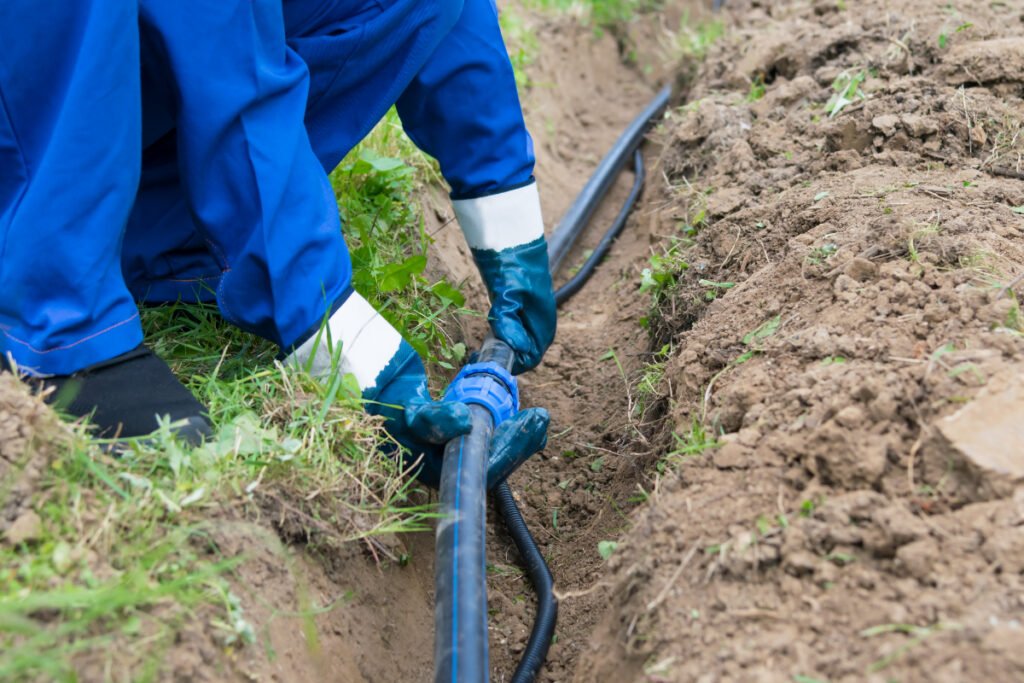
What Is It: A curtain drain is a shallow perimeter drain with a small 2-foot catch basin and PVC pipe that collects your yard’s surface water and drains to the main sewer or dry well.
How Does It Work: A curtain drain creates a block at the ground level and catches all the water in its catchbasin. Later, it transfers it to the drain pipe and moves it to local sewer lines or harvesting systems.
A curtain drain is a surface drain that collects the landscape’s excess water and discharges it downhill. Thus, it is smaller than a french drain and cannot bear heavy driveways and patios. It also has slower drainage and might need sump pumps for efficiency.
Usually, curtain drains run right in front of the house and are easily visible. But, it also makes them easier to install, clean, and maintain. They can even be re-excavated to hold more water periodically.
However, this drain system might clog due to excess soil and require periodical cleaning for optimal function. Or, you can use them with a drain tile and prevent excess sedimentation in the trench.
Overall, curtain drainage systems are the best bet for heavy rainfall areas and help prevent excess flooding around the house.
| Average Cost | $ 10 – 25 per linear foot |
| Average Lifespan | 6 – 7 years |
| Pipe Materials | Solid or perforated PVC pipe |
Use high-pressure water hoses or jets to unclog the perforated pipe, or use a sump pump to maintain the proper drainage speed inside.
Differences Between a French Drain and a Curtain Drain
French drains and curtain drains are quite similar in installation and mechanism. Still, they are used for different types of runoff with different depths, costs, and installations.
So, let’s compare the different drainage systems and pick the right one to solve your yard drainage problem.
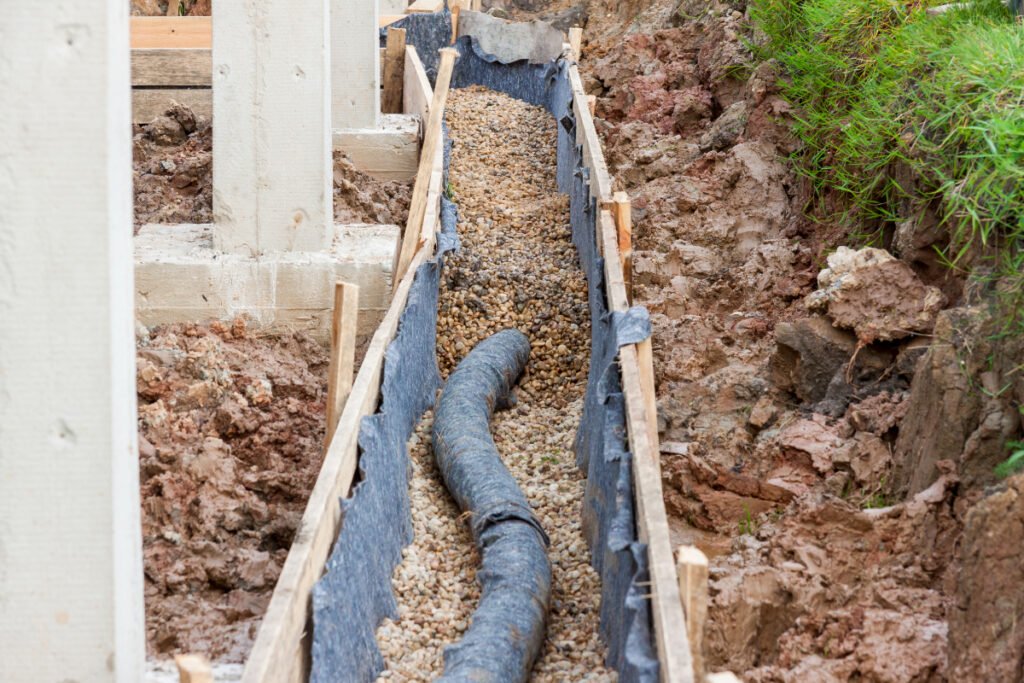
1. Location
A french drain is a footing drain mounted just above or below the foundation, cellars, basements, or crawl space. You may also find it around the retaining wall or ramp to reduce the hydrostatic pressure from groundwater.
Contrary to french drains, curtain drains are installed near the landscape and pathways for better surface drainage. Moreover, you can have a french drain on both sides of the wall, but you must limit curtain drain only for the house exteriors.
2. Cost
Curtain drains are quite affordable and cost about $10 – 25 per linear foot, whereas french drains are moderately expensive and might cost about $90 per foot for deeper excavations and packing.
Overall, the french drain cost ranges from $13,000-15,000, while curtain drains cost $5000-6000 in total.
3. Piping
A french drainage system works with a perforated or corrugated pipe and discharges the excess standing water to the surrounding soil.
On the other hand, curtain drains work with solid pipes and prevent groundwater percolation along the drain route.
4. Function
A french drain discharges groundwater and protects your foundations, retaining walls from further decay and damage, whereas a curtain drain system absorbs the surface water and prevents water from clogging the pathways and parking lots.
5. Installation
French drain installation is a bit tedious and needs precise slope, gravel lining, and mounting by a professional french drain man, whereas curtain drains are easy to install and can be manually dug and packed.
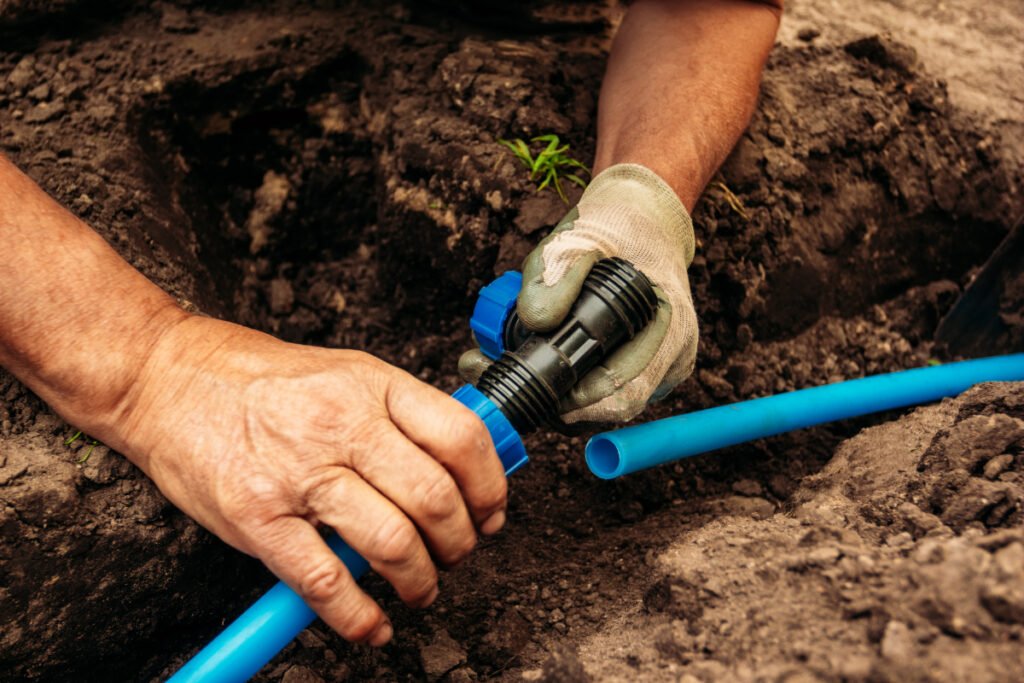
Here are some more differences in comparing a french drain and a curtain drain:
| Parameter | French Drain | Curtain Drain |
| Maximum Depth | 10 – 20 feet | 12 inch – 2 feet |
| Type of Water Runoff | Surface, Footing or Groundwater | Surface, Storm and Roof water |
| Maximum Width | 36 – 48 inches | 12 – 18 inches |
| Cost | $ 10 – 90 per linear foot | $ 10 – 25 per linear foot |
| Location | Basement, Foundation and Ramps | Around the house, Pathways and Paved areas |
| Visibility | Well-hidden in the trench, under gravel and grass | Easily visible in front of the house |
| Soil Type | Loamy or Coarse | It works with proper support in clay soil too |
| Drainage Speed | Average to Fast, depending on the sediment | Slow to Average with a sump pump |
| Water Capacity | 240 gallons per minute | 90 – 120 gallons per minute |
What Type of Drain Is the Best for Water Flow?
A french drain is the best for fast drainage and can move about 240-250 gallons per minute in heavy rainfall areas. In contrast, curtain drains are much slower and carry 90-120 gallons per minute using sump pumps and larger 6-inch pipes.
You can use a larger 12-16 inch perforated pipe to enhance the french drain’s efficacy and help it carry more water in flooded areas. And you can check the best drain pipe for a french drain here.
What Type of Drain Collects the Water Runoff?
A curtain drain is the best to absorb surface runoff and has several 2-foot catchbasins that assist the water collection. A french drain only collects the excess water near the gravel and footing but won’t keep your patios dry.
Which Drain Is the Best Under Driveways and Parking Lots?
A french drain is an excellent choice to prevent flooding and surface water percolation under the driveways and parking lots. It can withstand the weight of heavier vehicles effortlessly. And you can even pack it with closely bound gravel to protect the pipe from crushing.
Line the drain with a 1-2 inch french drain rock and use sturdier woven landscape fabric for better vibration absorption and security.
What Type of Drain Is the Best for Clay Soil?
A curtain drain is more efficient for clay soils and can be re-excavated and repacked to maintain the desired depth and water flow.
Compared to a curtain drain, french drains might buckle or clog due to the excess sedimentation in clay soils and lose their efficacy with time.
Spread a studier landscape fabric over the curtain drain to support the trench and prevent the soil from sliding inside.
Tips for Choosing the Best Type of Drain for Your Yard
- Pick curtain drains for ground-level drainage to protect your landscape while choosing french drains to secure your footing.
- Install deeper french drains to prevent water damage near your foundations, basements, and cellars.
- Limit french drains to sub-surface water drainage, and avoid them in clay soils or planted areas that might damage their pipe.
- Use french drains for wider sites and larger yards, but restrict curtain drains to small and compact sites.
- Choose curtain drains for smaller attached or detached garages, but pick french drains for basement garages and carports.
Do Curtain Drains Clog?
Yes, curtain drains might clog due to excess sedimentation or soil deposition on the trench’s side and might need some excavation to restore the water flow. Or, heavy tree roots or branches might fall on the drain, crush it and stop the water flow.
When Should You Use a French Drain?
Use french drains for heavily-saturated or soggy soils that might trap excess water along your gardens and basements and flood the entire site. And you can install french drains along ramps and retaining walls to avert water damage and hydrostatic pressure.
Do French Drains and Curtain Drains Increase Home Value?
Yes, french drains and curtain drains increase the home value by about 1 – 1.5%, depending on the location and depth. Plus, they protect your foundations and keep your home in good shape for resale.
Both french drains and curtain drains are surface drainage systems, but french drains channel water underground, whereas curtain drains collect surface water and prevent flooding.
So, now that we compared all the drain attributes, it’s time to pick one and solve your drainage problem instantly! However, you can also use other french drain alternatives, like trench drain, dry well, and catch basin. Want to know more? Join us now!

